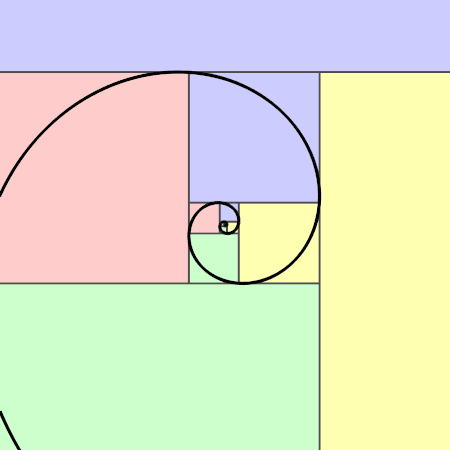Cosmic Patterns: How the Fibonacci Sequence Connects Nature and the Universe

The Fibonacci Sequence, Golden Ratio and Golden Spiral
An introduction to the world of sequences and ratios
Introduction to the Fibonacci Sequence
The Fibonacci Sequence is a set of integers in which each number, except for the first two, is equal to the sum of the two preceding ones. Numbers that are part of the Fibonacci sequence are known as Fibonacci numbers, and are denoted Fn .
The Fibonacci sequence begins with the following 10 integers:
0, 1, 1, 2, 3, 5, 8, 13, 21, 34 ...
The Fibonacci numbers can be defined using a recurrence relation. A recurrence relation is an equation that defines a sequence in terms of its previous term(s). The simplest form of a recurrence relation occurs where the next term depends only on the immediately previous term. In the case of the Fibonacci sequence, each term depends on its two preceding terms, which can be mathematically represented as follows:
Fn = Fn−1 + Fn−2
F0 = 0 (applies only to the first integer)
F1 = 1 (applies only to the second integer)
where n > 0.
Each number in the sequence is represented by the expression Fn and n reflects the number's position in the sequence, starting with zero. Therefore, the first term is referred to as F0 while the tenth term is referred to as F9 .
The challenge with this formula is that it relies on knowing the previous Fibonacci numbers in order to calculate a specific n term. With this logic, it would not be possible to calculate the value of the 46th term without defining the 45th and 44th terms, which in turn, requires you to define all the terms that come before them.
Who Came up With the Fibonacci Sequence?
Many regard Leonardo Fibonacci (c. 1170 - c. 1240-50) as the discoverer or "inventor" of the Fibonacci sequence. He was an Italian mathematician from the Republic of Pisa, and was initially known as Leonardo of Pisa but later nicknamed Fibonacci (meaning "son of the Bonacci clan") by 19th century historians to distinguish him from another famous Leonardo of Pisa.
Throughout his career, he wrote many influential works on mathematics, including Liber abaci (1202; "Book of the Abacus"), which introduced Hindu-Arabic numerals to Europe. The first seven chapters explained the use of numerals in arithmetical and practical operations as well as the principle of a place value: how the position of a figure within a numeral determines whether it is a unit 10, 100, etc. The rest of the work was devoted to speculative mathematics, exploring the concept of proportion, the Rule of False Position, properties of numbers, extraction of roots, geometry and algebra. It was also in the Liber abaci that Fibonacci proposed the following problem:
A certain man put a pair of rabbits in a place surrounded on all sides by a wall. How many pairs of rabbits can be produced from that pair in a year if it is supposed that every month each pair begets a new pair which from the second month on becomes productive?
The Fibonacci sequence can be derived from this problem, resulting in the same series we looked at previously.
In 1634, French-born mathematician Albert Girard created the formula un + 2 = un + 1 + un to determine the terms in the sequence. And in 1753, mathematician Robert Simson at the University of Glasgow, observed that as the numbers in the sequence increased in magnitude, the ratio between succeeding numbers approached the number α, known as the golden ratio, whose value is (1+√5)/2 or 1.6180...
However, it was not until French mathematician Edouard Lucas coined the term Fibonacci sequence that scientists began to take great interest in its unique properties. As a result, discoveries of similar sequences in nature began to surge; for example, in the spirals of sunflower heads, animal horns, pine cones and the arrangement of leaf buds on a stem.
The Golden Ratio
The golden ratio, also known as the divine proportion, is a ratio between two numbers approximating 1.618, often denoted by the Greek letter φ (phi). It was first mentioned in Euclid's Elements (300 BCE), the Classical Greek work on mathematics and geometry comprising 13 books. Euclid, in The Elements, states that you can find the Golden Ratio when you divide a line into two parts and the longer part (a) divided by the smaller part (b) is equal to the sum of (a) + (b) divided by (a), both of which equate to 1.618.
While Euclid recognised the proportion, it was not referred to as the Golden Ratio. It was not until much later, in 1509, that Italian mathematician Luca Pacioli described the divine simplicity of the ratio in his book De divina proportione, thus allowing the ratio to gain fame and recognition amongst mathematicians, architects and artists.
It is argued that the number is naturally pleasing to the eye, perhaps due to its commonality in the natural world. The Golden Ratio can be seen in the arrangement of leaves around a stem, the branching of trees, the arrangement of flower petals, and the patterns of various fruits and vegetables. The Golden Ratio has been used in the design of some famous artworks and architectural structures. For example, the Parthenon in Greece, Leonardo da Vinci's "Vitruvian Man" and the pyramids of Egypt.
Also surprising is that any Fibonacci number can be calculated using the Golden Ratio with the following formula:

So for example, F9 can be calculated as the following:

Which gets us roughly 34.
The Golden Rectangle and the Golden Spiral
The Golden Rectangle is a rectangle whose side lengths are in the golden ratio. This means that by dividing the longer side (a) by the shorter side (b), the result is φ (phi). A unique property of the golden rectangle is that if you remove a square with side lengths equal to the shorter side of the rectangle, the remaining rectangle will also be a golden rectangle. In fact, the golden rectangle is the only rectangle that can be cut so that the remaining rectangle will always be similar to the original rectangle.

Draw a quarter-circle inside each square, with the center at one corner of the square and a radius equal to the square's side length. These quarter-circles will together form a continuous spiral, approximating a unique spiral known as the Golden Spiral.
The Golden Spiral is a logarithmic spiral whose growth factor is φ. Interestingly, Swiss mathematician, Jacob Bernoulli, was so impressed by the mysticism of this spiral that he requested it to be engraved on his gravestone together with the Latin phrase “eadem mutata resurgo”, (“Although changed, I arise again the same.”)

Creating a Golden Spiral involves plotting quarter-circle arcs within a series of adjoining squares whose side lengths are Fibonacci numbers. Here’s a step-by-step guide to constructing such a spiral:
- Fibonacci Sequence: Recall that the Fibonacci sequence starts with 0,1,1,2,3,5,8,13,…, where each number is the sum of the two preceding ones.
- Create Squares: Draw squares whose side lengths correspond to the Fibonacci numbers, arranging them in a way that each new square shares a side with the previous one.
- Arrange the Squares:
- Start with a 1x1 square.
- Attach another 1x1 square to one side.
- Attach a 2x2 square to one of the previous squares.
- Continue with 3x3, 5x5, 8x8 squares, and so on.
The squares will be placed counterclockwise or clockwise, forming a larger composite rectangle.

- Draw Arcs: Within each square, draw a quarter-circle arc. Each arc connects two corners of a square.
- Start from one corner of the first 1x1 square and draw an arc to the adjacent corner.
- Continue this process for each subsequent square, drawing an arc from one corner to the adjacent corner in the same rotational direction (either all clockwise or all counterclockwise).
If we draw a diagonal from the top right of the original rectangle to the bottom left, and then from the bottom right of the next smallest rectangle to the top left, the intersection point shows the point to which all the rectangles converge. Moreover, the lengths of the diagonals are in golden ratio to each other. For this reason, the convergent point is often referred to as the "Eye of God".

The Fibonacci Sequence in Nature
Math is everywhere we look
Sunflowers and Leaves
The Fibonacci sequence appears quite frequently in nature. For example, the spirals of seeds on a sunflower head or the arrangement of leaves around a stem are all governed by the Fibonacci sequence. The patterns allow the most efficient packing of seeds in a sunflower or leaves around a stem, ensuring maximum exposure to sunlight and rain.

Looking more closely at the sunflower head, one will observe patterns spiral of seeds, starting in the centre and curving outwards, left and right. If you count the spirals, your total will be a Fibonacci number. Further, if you divide the spirals into those curving left and those curving right, you'll find two consecutive Fibonacci numbers. Similar spiral patterns reflecting the Fibonacci sequence can also be seen in pinecones, pineapples, and cauliflower.
Tree Branches
Surprisingly, the Fibonacci pattern can also be observed in trees. The Fibonacci begins in the trunk and then spirals outward as the tree gets larger (width-wise) and taller. We also see the golden ratio in the branches: one trunk splits into 2, then one of the new branches stems into 2, and so on. Thus, creating a sequence almost identical to that of the Fibonacci.

Seashells
Nautilus is a variant of seashells that displays a spiral pattern adhering closely to the Fibonacci sequence. Each chamber of the nautilus shell grows in size following the Fibonacci numbers, and so too, the Golden Ratio. This creates a spiral that is both aesthetically pleasing and mathematically fascinating.

Galaxies
A similar spiral is also present in the "arms" of galaxies. In the universe, there is a type of galaxy called a spiral galaxy which typically has a rotating disc with spiral "arms" that curve out from a dense central region; An example of this is the Milky Way.

The golden spiral can be found in the shape of the "arms" of galaxies if you measure them and do the math.
Final Conclusions and Personal Thoughts
One of the reasons why math is so dear to me is because it can be found anywhere. Nearly everything in this world can be explained mathematically, and if not, then there is a new mathematical concept that has yet to be discovered!
Whilst doing the research for "The Fibonacci Sequence in Nature" section, I could not help but wonder whether or not these mathematical discoveries are our predetermined destiny; if things like the Golden Ratio or the Fibonacci sequence have existed all this time, just waiting for us to discover them. There are many different opinions regarding these thoughts. Some argue that mathematics is independent of us all, that it was here long before we evolved and will continue to exist after our extinction. Others argue that mathematics is a tool of our creation, built in such a way that it merely corresponds to the universe. As much as I would like to think that mathematics is independent of human creation, a part of me is doubtful whether that is the case.
I believe that the universe is constructed in such a way that everything fits beautifully together, like the gears of a clock, constantly turning and rotating to create a harmonious balance. The probability of human existence is infinitesimally small, so for us to be here is proof enough that the universe is far beyond our comprehension. Perhaps that is why mathematics exists; It is a logic-based language that helps us grasp the complexity of the world in which we live. Just like how an artist uses paint to capture the beauty of a landscape, we use mathematics to capture the beauty of the universe.
Mathematics is, in its own way, the poetry of logical ideas. - Albert Einstein



